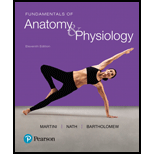
Concept explainers
Identify the three types of muscle tissue and cite their major functions.
To determine:
The three types of muscle tissue and their functions.
Introduction:
Muscle tissues are mainly of three types, skeletal muscles, cardiac muscles and smooth muscles. Skeletal muscles are voluntary muscles and are attached to the skeleton system of the body. Cardiac muscles are involuntary muscles of the heart. Smooth muscles are also involuntary muscles and are found in intestinal walls.
Explanation of Solution
The three types of muscles are as follows:
Skeletal Muscle:
The cells of this tissue are cylindrical and long in shape and are multinucleated. They are mainly found in attached to the bones with the help of tendons.
The primary function of the skeletal muscle is in the movement and stabilization of the skeleton. These muscles help in insulation and also act as a protection for internal organs.
Cardiac Muscle:
The cells of this tissue are short and branched. They are made up of uninucleate cells which are connected by intercalated discs. They are found in the heart. The primary function of the cardiac muscle is the pumping and circulation of blood and maintenance of blood pressure.
Smooth Muscle:
The cells of smooth muscles are short and spindle shaped. They are uninucleate cells. They are found in the respiratory and digestive tract. These muscles are involved in the peristaltic movement, and the reproductive secretions. These are also involved in regulation of the diameter of blood vessels.
Muscle tissues are mainly of three types, skeletal muscles, cardiac muscles and smooth muscles.
Want to see more full solutions like this?
Chapter 10 Solutions
Fundamentals of Anatomy & Physiology, Custom edition for Houston Community College Northwest, Volume 1, Includes student access code card
- Noggin mutation: The mouse, one of the phenotypic consequences of Noggin mutationis mispatterning of the spinal cord, in the posterior region of the mouse embryo, suchthat in the hindlimb region the more ventral fates are lost, and the dorsal Pax3 domain isexpanded. (this experiment is not in the lectures).a. Hypothesis for why: What would be your hypothesis for why the ventral fatesare lost and dorsal fates expanded? Include in your answer the words notochord,BMP, SHH and either (or both of) surface ectoderm or lateral plate mesodermarrow_forwardNot part of a graded assignment, from a past midtermarrow_forwardNot part of a graded assignment, from a past midtermarrow_forward
- please helparrow_forwardWhat does the heavy dark line along collecting duct tell us about water reabsorption in this individual at this time? What does the heavy dark line along collecting duct tell us about ADH secretion in this individual at this time?arrow_forwardBiology grade 10 study guidearrow_forward

 Concepts of BiologyBiologyISBN:9781938168116Author:Samantha Fowler, Rebecca Roush, James WisePublisher:OpenStax College
Concepts of BiologyBiologyISBN:9781938168116Author:Samantha Fowler, Rebecca Roush, James WisePublisher:OpenStax College Human Physiology: From Cells to Systems (MindTap ...BiologyISBN:9781285866932Author:Lauralee SherwoodPublisher:Cengage Learning
Human Physiology: From Cells to Systems (MindTap ...BiologyISBN:9781285866932Author:Lauralee SherwoodPublisher:Cengage Learning Human Biology (MindTap Course List)BiologyISBN:9781305112100Author:Cecie Starr, Beverly McMillanPublisher:Cengage Learning
Human Biology (MindTap Course List)BiologyISBN:9781305112100Author:Cecie Starr, Beverly McMillanPublisher:Cengage Learning





